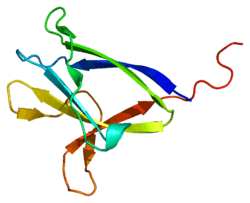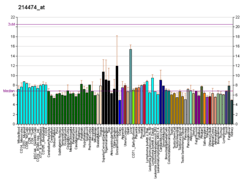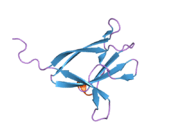PRKAB2
5'-AMP-activated protein kinase subunit beta-2 is an enzyme that in humans is encoded by the PRKAB2 gene.[5][6]
The protein encoded by this gene is a regulatory subunit of the AMP-activated protein kinase (AMPK). AMPK is a heterotrimer consisting of an alpha catalytic subunit, and non-catalytic beta and gamma subunits. AMPK is an important energy-sensing enzyme that monitors cellular energy status. In response to cellular metabolic stresses, AMPK is activated, and thus phosphorylates and inactivates acetyl-CoA carboxylase (ACC) and beta-hydroxy beta-methylglutaryl-CoA reductase (HMGCR), key enzymes involved in regulating de novo biosynthesis of fatty acid and cholesterol. This subunit may be a positive regulator of AMPK activity. It is highly expressed in skeletal muscle and thus may have tissue-specific roles.[6]
Related gene problems
Interactions
PRKAB2 has been shown to interact with PRKAG2[7] and PRKAG1.[7]
Research on the genes CHD1L and PRKAB2 within lymphoblast cells[8] lead to the conclusion that anomalies appear with the 1q21.1 deletion syndrome:
- CHD1L is an enzyme which is involved in untangling the chromatids and the DNA repair system. With 1q21.1 deletion syndrome a disturbance occurs, which leads to increased DNA breaks. The role of CHD1L is similar to that of helicase with the Werner syndrome
- PRKAB2 is involved in maintaining the energy level of cells. With 1q21.1-deletion syndrome this function was attenuated.
References
- 1 2 3 GRCh38: Ensembl release 89: ENSG00000131791 - Ensembl, May 2017
- 1 2 3 GRCm38: Ensembl release 89: ENSMUSG00000038205 - Ensembl, May 2017
- ↑ "Human PubMed Reference:".
- ↑ "Mouse PubMed Reference:".
- ↑ Stapleton D, Mitchelhill KI, Gao G, Widmer J, Michell BJ, Teh T, House CM, Fernandez CS, Cox T, Witters LA, Kemp BE (February 1996). "Mammalian AMP-activated protein kinase subfamily". J Biol Chem. 271 (2): 611–4. doi:10.1074/jbc.271.2.611. PMID 8557660.
- 1 2 "Entrez Gene: PRKAB2 protein kinase, AMP-activated, beta 2 non-catalytic subunit".
- 1 2 Cheung, P C; Salt I P; Davies S P; Hardie D G; Carling D (March 2000). "Characterization of AMP-activated protein kinase gamma-subunit isoforms and their role in AMP binding". Biochem. J. ENGLAND. 346 (3): 659–69. doi:10.1042/0264-6021:3460659. ISSN 0264-6021. PMC 1220898. PMID 10698692.
- ↑ Harvard C, Strong E, Mercier E, Colnaghi R, Alcantara D, Chow E, Martell S, Tyson C, Hrynchak M, McGillivray B, Hamilton S, Marles S, Mhanni A, Dawson AJ, Pavlidis P, Qiao Y, Holden JJ, Lewis SM, O'Driscoll M, Rajcan-Separovic E (2011). "Understanding the impact of 1q21.1 copy number variant". Orphanet J Rare Dis. 6: 54. doi:10.1186/1750-1172-6-54. PMC 3180300. PMID 21824431.
Further reading
- Gao G, Fernandez CS, Stapleton D, et al. (1996). "Non-catalytic beta- and gamma-subunit isoforms of the 5'-AMP-activated protein kinase". J. Biol. Chem. 271 (15): 8675–81. doi:10.1074/jbc.271.15.8675. PMID 8621499.
- Woods A, Cheung PC, Smith FC, et al. (1996). "Characterization of AMP-activated protein kinase beta and gamma subunits. Assembly of the heterotrimeric complex in vitro". J. Biol. Chem. 271 (17): 10282–90. doi:10.1074/jbc.271.48.30517. PMID 8626596.
- Bonaldo MF, Lennon G, Soares MB (1997). "Normalization and subtraction: two approaches to facilitate gene discovery". Genome Res. 6 (9): 791–806. doi:10.1101/gr.6.9.791. PMID 8889548.
- Stapleton D, Woollatt E, Mitchelhill KI, et al. (1997). "AMP-activated protein kinase isoenzyme family: subunit structure and chromosomal location". FEBS Lett. 409 (3): 452–6. doi:10.1016/S0014-5793(97)00569-3. PMID 9224708.
- Thornton C, Snowden MA, Carling D (1998). "Identification of a novel AMP-activated protein kinase beta subunit isoform that is highly expressed in skeletal muscle". J. Biol. Chem. 273 (20): 12443–50. doi:10.1074/jbc.273.20.12443. PMID 9575201.
- Cheung PC, Salt IP, Davies SP, et al. (2000). "Characterization of AMP-activated protein kinase gamma-subunit isoforms and their role in AMP binding". Biochem. J. 346 (3): 659–69. doi:10.1042/0264-6021:3460659. PMC 1220898. PMID 10698692.
- Xu XR, Huang J, Xu ZG, et al. (2002). "Insight into hepatocellular carcinogenesis at transcriptome level by comparing gene expression profiles of hepatocellular carcinoma with those of corresponding noncancerous liver". Proc. Natl. Acad. Sci. U.S.A. 98 (26): 15089–94. Bibcode:2001PNAS...9815089X. doi:10.1073/pnas.241522398. PMC 64988. PMID 11752456.
- Park SH, Paulsen SR, Gammon SR, et al. (2003). "Effects of thyroid state on AMP-activated protein kinase and acetyl-CoA carboxylase expression in muscle". J. Appl. Physiol. 93 (6): 2081–8. doi:10.1152/japplphysiol.00504.2002. PMID 12433937.
- Strausberg RL, Feingold EA, Grouse LH, et al. (2003). "Generation and initial analysis of more than 15,000 full-length human and mouse cDNA sequences". Proc. Natl. Acad. Sci. U.S.A. 99 (26): 16899–903. Bibcode:2002PNAS...9916899M. doi:10.1073/pnas.242603899. PMC 139241. PMID 12477932.
- Prochazka M, Farook VS, Ossowski V, et al. (2003). "Variant screening of PRKAB2, a type 2 diabetes mellitus susceptibility candidate gene on 1q in Pima Indians". Mol. Cell. Probes. 16 (6): 421–7. doi:10.1006/mcpr.2002.0439. PMID 12490143.
- Ota T, Suzuki Y, Nishikawa T, et al. (2004). "Complete sequencing and characterization of 21,243 full-length human cDNAs". Nat. Genet. 36 (1): 40–5. doi:10.1038/ng1285. PMID 14702039.
- Minokoshi Y, Alquier T, Furukawa N, et al. (2004). "AMP-kinase regulates food intake by responding to hormonal and nutrient signals in the hypothalamus". Nature. 428 (6982): 569–74. Bibcode:2004Natur.428..569M. doi:10.1038/nature02440. PMID 15058305.
- Gerhard DS, Wagner L, Feingold EA, et al. (2004). "The Status, Quality, and Expansion of the NIH Full-Length cDNA Project: The Mammalian Gene Collection (MGC)". Genome Res. 14 (10B): 2121–7. doi:10.1101/gr.2596504. PMC 528928. PMID 15489334.
- Kimura K, Wakamatsu A, Suzuki Y, et al. (2006). "Diversification of transcriptional modulation: Large-scale identification and characterization of putative alternative promoters of human genes". Genome Res. 16 (1): 55–65. doi:10.1101/gr.4039406. PMC 1356129. PMID 16344560.
- Gregory SG, Barlow KF, McLay KE, et al. (2006). "The DNA sequence and biological annotation of human chromosome 1". Nature. 441 (7091): 315–21. Bibcode:2006Natur.441..315G. doi:10.1038/nature04727. PMID 16710414.
- Ewing RM, Chu P, Elisma F, et al. (2007). "Large-scale mapping of human protein–protein interactions by mass spectrometry". Mol. Syst. Biol. 3 (1): 89. doi:10.1038/msb4100134. PMC 1847948. PMID 17353931.






